In its work, post-discplinary studio El Ultimo Grito questions design to better understand its underlying nature.
“There is a certain moment when you, as designer, begin to look at the wider senses of design, at what design is, and what design means. For us the definition of design became the process by which we materialise ideas," explains Roberto Feo, who founded the London-based studio with his wife and fellow Spaniard, Rosario Hurtado. “And when you consider it in this context, design is absolutely everything. We all know that we are surrounded and mediated by design. The thing is to intellectually engage with it. Design is an approach that goes beyond the simple answer to a brief, to a multitude of possibilities that paint a picture of what the subject is that is being explored.”
Speaking at the 2014 Design Indaba Conference, Hurtado says that on a very basic level, design is about producing products. "So design is something that takes you to the product, it is a process," she says.
She shows several examples of their early work that speaks to understanding design in this way. Part of this is also understanding the industry that produces the object, the system of commerce that sells it and its communication.
El Ultimo Grito's design of a children’s toy for Magis, called MICO, was their first work that consciously challenged this idea of design and its ecosystem.
Feo says the toy was inspired by playing hide-and-seek with his daughter. Because their apartment is relatively small, there is not a lot of hiding space and so he would simply lie on the couch and cover himself with a blanket.
“When she asked ‘where are you?’, I replied ‘I’m in the book’ and I could hear her flipping through the pages. She then asked what page I was hiding on. What is important is that for her the huge volume on the sofa is less real than the possibility of a space existing inside a book. And that is the power of what it is to be a child,” he explains.
He goes on to say that toys are often designed to bring children into the world that we know, to educate them, but if we could retain this feeling of possibility then we would understand and relate to culture and the objects around us quite differently.
Their design of MICO encourages this by not carry any specific typology in the form. Instead, the form allowed multiple stories or scenarios to be completed through play. According to Feo, children immediately got it but it wasn't necessarily a commercial success.
It is probably one of the only mass-produced objects that has only been sold to museums, he jokes.
The experience made the pair realise that an object had a limited capacity to express what they wanted to say.
“We thought, the problem is you have a whole system that delivers an object at the end – from the education that teaches design, to the industry that makes the object, and the agency that produces the communication of the object. We had the feeling that we were dependent on the system. We wanted to challenge parts of this process,” says Rosario.
They found inspiration in William Blake, who said, “I must create a system or be enslaved by another man’s.” This resonated with them as they sought ways to change the design process as it conventionally understood.
We started working with materials that don't dictate how you need to use them or join them or what tools are required, explains Hurtado.
They built structures out of packing materials, working in a very physical way – "not only using the hand but also the body in public spaces”.
The structure was made of timber, bubble wrap and packaging tape. First they built an armature of timber in response to the features of a particular space, then wrapped it in bubble wrap and secured it with the tape. To give the structure cohesion as a single object, they applied graphic stickers across its surface to form a fractal skin.
This methodology allowed them to take design to a more primitive level where the tools don't dictate what is designed.
The materials used and the manner in which they are applied result in a mish-mash of mass-production and craft. The sheer number of the stickers used – in one case up to 19,000 – introduces an industrial element to the hand-built structure.
They go on to show three examples of work produced in this way.
The first, a 30-metre table made of cardboard, questioned how market value is defined and whether such a table is a sellable product.
The second, a seating installation on a public square in Mexico City, gave rise to some exciting insights. They discovered it was "not a matter of aesthetics – whether you like[d] it or not, whether it [was] good or bad design" but about "people embrac[ing] it and join[ing] in". Hurtado says: "There is a joy of actually working like this."
Feo put is this way: “In the public space, the object doesn't need any presentation. It happens and people will use it whether it looks this or that.”
Their work, he says, lives in two places: in galleries or public spaces. Every time they do an installation, they say, they need to understand what it brings into the context. They view their gallery work as “live prototyping at full scale”.
The third example of work they show, “Garden Objects”, is an abstract structure that melds the traditional English garden with Hieronymus Bosch’s famous painted triptych "Garden of Earthly Delights" at Rice University Art Gallery.
Beyond the pair's work as El Ultimo Grito, they also have a side project with a group of collaborators called POI (Point Of Interest).
Members of the project meet every Saturday to discuss design.
These dialogues were becoming like design itself. They were finding solutions to challenges.
"These were modulated through fanzines that became books and then sparked projects,” they say.
One of POI's conceptual projects, Collapscapes, explores their fascination with how industrial architecture artificially collapses time and space for efficient production.
They end their presentation with 3 trailers that explore how cinema collapses time and space by connecting unrelated spaces to create a film's landscape.









